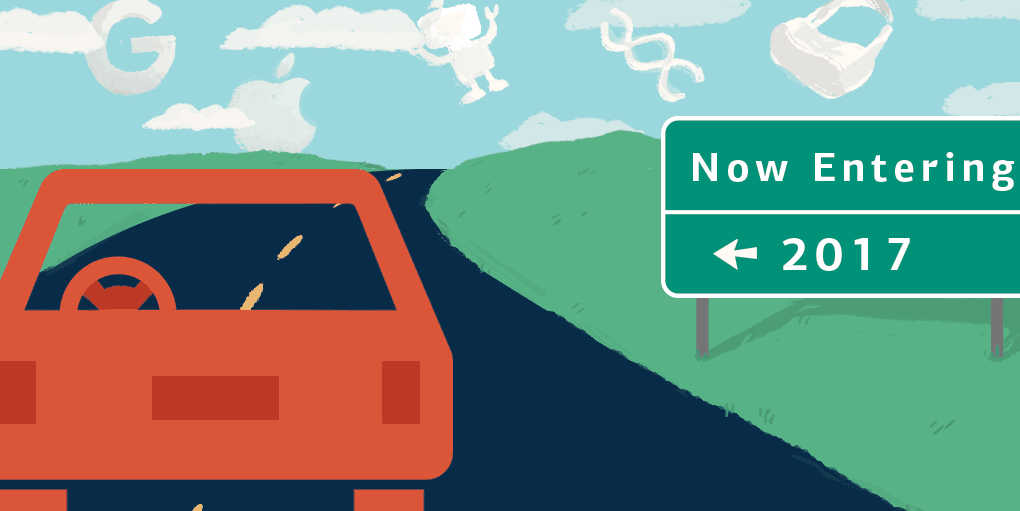
For the second year in a row, we gathered in the big conference room, fired up Slack, and discussed what we think the future holds for the world of design in the upcoming 12 months. Personalization, VR, and even genetics all make an appearance in our forecast for 2017.

Channeling my best inner moderator, my question to start is this: What’s in store for design in 2017?

I can kick it off with the topic of personalization. It seems we’re nearing fever pitch in our appetite for personalization and companies will be needing to invest in roadmaps that account for continuously sophisticated personalization of services, content, and features.

What do you mean by personalization?

Content that is specific to each user and their current needs and behaviors.

One thing that comes to mind is integrating more conversational language into the user experience.

I think what IFTTT is doing is really interesting. It is exposing users to all different kinds of ways to personalize their app experiences that are crowd-sourced and not directly offered from the app itself.

At least when I hear the word personalization I think of the data that companies collect and are able to use to provide better information or context for users.

I was going to say the same thing Aarti! Something that came to mind from Isaac’s topic is conversational UIs – the industry has started off with heavy personalization via conversational UI service (I think of Uber via Facebook messenger) – maybe what’s next is anticipatory conversational UI. An AI that recognizes the need and offers a service before the user knows they need to ask for it. Basically that would imply an AI being increasingly aware of the world around it and the context around it, in relation to what it knows about you as the user.

I think that’s the essence of personalization. It’s providing relevant content, features, benefits without requiring the user to ask for it. Think of GPS data suggesting what apps you use in this location or that.

Do people think conversational UI or chatbots are true personalization or just a way to “fake” it? By engaging in conversations it feels very personal but it tends to be slightly artificial.

Absolutely agree with Mark’s comment. It’s a bit of knowing what’s behind the curtain per se, we know there’s not another person there so it will always fall short of that expectation in some regard.

Yeah but that’s what will end up taking chatbots to another level. The ability to sense that the chatbot is actually objectively thinking about your needs and is empathetic instead of running through a script.

Agreed, Julia — if they can get there without falling into the uncanny valley.

Wow that’s a really great connection!

Julia mentioning chatbots being “empathetic” reminds me of an event that I was invited to. The description sounds like it was promoting that current chatbots are basically the exact opposite. (Not very positive) Food for thought from the description: “Sociopathy is two things: not gauging emotion on the input, and not expressing emotion on the output. Sociopaths don’t understand your smile, and don’t know to smile to express their feelings. That’s what AI is–this is the danger. AI doesn’t know how you feel and it doesn’t care. The industry standard is canned animation; it’s like a phone tree plugged into a game engine. People are investing in a sociopath to represent their companies, and that will be a disaster.”

On that positive note, we’ve heard a lot around what’s going on now, but what do we think is coming in 2017? Are we going to fall into the depths of the uncanny valley? Are we stuck with sociopath robo-assistants in our house? Will they succeed or fail?

Well I have another question for you as well. If robots DO become a true AI, which is thinking and understanding, then how will people communicate with them? Will people become more respectful to AI when they are aware that it is no longer going off of a script? Also I have to think about kids growing up with this tech. How will your world view change when you are used to barking off commands?

I think there will always be a spectrum of poor understanding of users and better understanding of users. If we do see more personalization through conversational UIs in 2017 I think we’re going to see a lot of the ways that companies don’t actually understand their users very well.
The best companies will be able to accurately model and anticipate what their users need and are doing in their experience and provide relevant content and features for them.

I would imagine there will be a continued progression of personalization – conversational UI – but no dramatic shifts. It’s not leaving, but not getting dramatically better in the next 12 months, either. We will see more integration into existing tools that have been in market for a while but most likely with limited success. It’s a tough “add-on” feature but works well in something like Slack because it’s built around it.

I think as AIs (like Watson) are used for deep machine learning, there will be a rising and equal need to present information gleaned from learning in a way that is consumable to users.

That’s very interesting, Aarti, and something to explore further. In terms of outlooks, Mark’s is rather tepid – any strong disagreements?

There will be eager companies and teams that try to implement the AI as cheap and quickly as possible. Those might be dramatic, but will be bad.

Agreed with Mark’s comment, further along than VR but still not quite there yet.

I think that’s a good call — would tend to agree.

Wrapping up the topic of personalization (implemented as an AI), I think it’s safe to say that Team Fuzzy Math is excited for the future, but doesn’t think that 2017 is the year it becomes a huge success.
Interestingly (and somewhat confusingly), we have three different threads going for what “personalization” even means: 1) content specific to users, 2) apps that help bring together other content in ‘personalized’ ways and 3) data collection and reuse. I think it’s interesting that how we are interpreting “personalization” is all over the place. Personalization is an interesting space.
Related to that, apps sitting between other apps are putting the human in charge to set them up, which seems very different than robo-assistants, which are seemingly in control of themselves. Two very different types of “personalization.”

It’s funny because I almost think of an app that sits between other apps as an “assistant” that helps me out. I’m not actually sure I’ve heard of a robo assistant but it sounds like they would have more autonomy and therefore more potential to be out of sync with their human users.

A… robiopath?

Isaac made a great analogy that an app that sat between other apps was more of a switchboard, but Google Home talks back to you. IFTTT apps just do their job; there is no communication.

Switching topics, what else are we expecting to see in the future?

Some focuses for tech in this next year I think will revolve around safety/home surveillance, Genetic/family tree/DNA, Social/Politics/Education.

Genetics was unexpected and very interesting! What’s coming in 2017 for the design of genetics?

Learning more about your own genetic profile connects with the idea of personalization in health, and how that can be integrated into wearables.


I think as with all technology, as it becomes cheaper, more and more advances are coming down the pipeline. Specifically with genetics, huge advances are allowing consumers to take advantage of once off-limits technology.

I wonder if there will be more success regarding improving human-human relationships versus human-computer relationships.

To that point, there’s also potential for social change. People realizing that we’re all connected in some way can help decrease the amount of prejudice (Hopefully? Maybe?). Check out this video.

So what does the above mean for 2017? What do we expect to see in terms of apps, social change, human-human communication?

There’s probably a very related trend — some people are seeking out human-to-human contact in areas they normally wouldn’t — as a response to too much screen time. For example, groups of people learning things they already know because they want to be around people and not online. Listen to minutes 11:00-14:00, or the entire thing, of this episode of Recode Decode which goes much more in depth.

We can’t ignore the idea that every input or output related to any connection on the web often makes its strongest business case because of the data that it contains. I don’t agree with that all the time, but it is a consideration.

What do we think the near future holds for interfaceless interfaces? Virtual reality, augmented reality, other types of reality?

I think it’s going to be useful in hospitals or places like retirement homes. I could see something like this branching off in use for places where people are not as tech savvy or have little mobility. They don’t really have to understand interfaces/technology, just use your voice in whatever language you know.

From the Guardian: Can virtual reality help women cope with childbirth?

The use in retirement homes is very interesting! Any examples of that being used today?


Use within hospitals is a really cool idea, not only does it empower patients to ask for care when they need it, it also could help create a connection even when patients are alone, which given the context can be pretty horrible for patients.

Note that some wearable devices will have elderly detractors: Seniors shy away from wearable devices for health — but shouldn’t

The innovation is there, but the question about wearables is: is it accurate?

Can you explain a bit more, Julia?

We did that wearables project a couple of summers ago and I was very disappointed at the inaccuracy of my wearable device which essentially demoted it to an expensive toy. It was “nifty,” opposed to “useful.”

I ended up using mine for almost two years and feel differently. The trend was what mattered to me. It was generalizable enough that I gained insights I didn’t have before about my sleep patterns, regardless of whether it was off an hour here or there.

Yeah, and inaccuracy can come in different flavors. E.g. if the battery dies, charging is a major interruption in the experience that requires people to be really on top of the maintenance.

I think we are getting really caught up in pioneering new avenues in tech, which is really cool, but we need to spend some time refining so that things like this don’t happen.

That’s interesting, Julia. What do you think is going to come of this in the future? Success immediately, success over time, failure immediately, failure over time?

Maybe the future will be wearables you don’t have to wear. Not sure what this looks like, maybe Alexa in your house can tell how many steps you take or it’s like really small – earrings?

Ben I think that internal teams will start trying to figure out ways to make wearables more useful. The beginning of the wearables market was so intensely focused on the novelty of a “future technology”, and people were excited for what it could mean. But in 2017 I feel that although mass marketed wearables might not truly become 100% useful, there will be more significant progress internally about wearables in the health segment. Although progress in healthcare usually lags.

Alright, new topic, and also our closing topic: parting thoughts! To each of you, what’s a topic we didn’t cover that you wish we did? What’s coming in 2017 and how do you feel about it? Is the future bright, bleak, or in-between?

One Language to Rule Them All: Emojis or Gifs as a universal language? i.e. One language – with the connectivity of the world through the internet and social platforms, I could see a pictoral type language that connects to many people regardless of native verbal tongue, used via the interwebs, phones, etc.

I’d like to talk about: Which user experience issues does Amazon Go eliminate from the regular grocery shopping experience? Will this model be applicable/adopted by other retail stores?
I think in 2017, there will not be any significant changes in Amazon Go-style grocery shopping, but there will probably be more of the cashiers without a register floating around stores that allow you to purchase whatever you would like wherever you are standing.
But I will say that one of the benefits of Amazon Go style grocery store is not only that time will be saved, but that people will also be spared from a feeling of judgement. Part of the reason why I think that online shopping has become so successful other than the sheer convenience, is the freedom of trying new things without someone’s opinion.
One potential detriment of the style of Amazon Go, is it requires a new interaction pattern with a store. If traditional stores co-exist with Amazon Go stores then there might be moments of accidental shoplifting [Editor’s note: “accidental”].

I know we didn’t get to it, but I think the Apple Touch bar is a huge step backward and likely that Apple is priming users for a full touch keyboard. I get that the function keys may not have been used, but it seems like the novelty factor won out over usability and utility. Not something I expected to come from Apple.

The UX associated with self-driving cars raises several challenges. How do we integrate a sense of trust into the design of self-driving cars? What will/should that experience look like? How should users/pedestrians interact with self-driving cars? What is our role as a passenger?

I wonder as things like conversational UIs and more advanced AIs come into play in the future, what will be the threshold for people thinking devices are getting too personal or too overbearing (and I’m biased because I’m a person who does not want to be bothered by multiple streams of notifications and assistance and messages). I think as a result of that some apps could be created that help people manage their interactions with technology, which seems counter intuitive, and the data about them that’s out there in the world.

Becca I feel this so much even with Howdy.

I’d like to touch on: After the success(?) of Pokémon Go, what does the future hold for augmented reality?
AR is still a technology seeking a valuable use. Games are just that — games. But the future of AR in 2017 is specific applications within business, manufacturing, and/or the enterprise. There are specific ways that people’s actual jobs can be made easier and more efficient, for example visually augmenting someone that monitors a plant floor. As AR starts to solve these problems in 2017 we’ll see greater usage and adoption

I echo @Mark’s sentiment about augmented reality.
- Look to companies aiming their investments into technology for the home that yields consumer data from that experience: Realtor.com uses augmented reality to help you find a new home
- Look to consumer products adding layers of AR to their services. Wayfair released AR with Lenovo that allows a virtual placement of furniture within one’s home.
- Look to increased use of augmented reality for empathetic law enforcement training. FBI’s report on Augmented reality: Police Augmented Reality Technology (pdf)

I’ve been using Headspace app recently which is a guided meditation app. I’m not sure if that categorizes as AR, but it can feel like it at times because it makes you feel in touch with the present world around you more than you might be if you were lost in your head. The effect of apps on mental health is an interesting topic for me.

That was a very fast hour in the conference room! We are full of ideas of what the future could hold in 2017 and personally, I am slightly surprised to see it was a pretty even mix of positive and negative.
What are you looking forward to in design in 2017? Let us know on Twitter @fuzzymath!